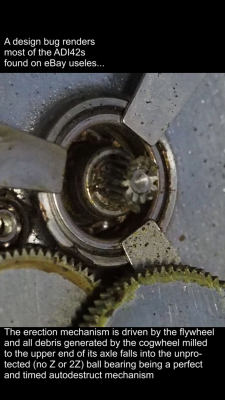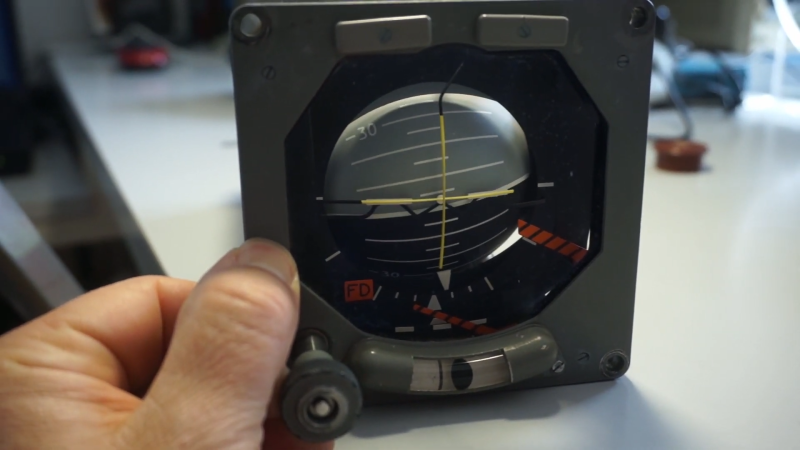Aviation instruments are highly interesting pieces of engineering, and it is quite satisfying to watch the often over-engineered mechanisms behind them. If you are into that sort of thing it is worthwhile to check out [Erik Baigar]’s video where he explains the working principle of the attitude indicator from a Tornado jet.

The attitude indicator or artificial horizon of an airplane is one of the most important instruments, especially during poor sight. The ADI42-124 used in the Tornado jet is completely standalone and only needs a DC power supply which is why [Erik Baigar] can show it off while standing on his balcony. At the heart of this instrument is a gyroscope which consists of a spinning disc attached to a gimbal mount. Due to the conservation of angular momentum, the spin axis will always keep its orientation when the instrument is rotated. However, mechanical gyroscopes tend to drift over time and therefore include a mechanism to keep the spin axis upright with respect to the direction of gravity. The ADI42-124 uses an entirely mechanical mechanism for this based on free swiveling weights. Forget everything we said earlier about overengineering as [Erik Baigar] also uncovers a fatal design flaw which leads to the instrument’s self-destruction as shown in the picture here. Unfortunately, this will render most of the units you can buy on eBay useless.
Be sure to check out [Erik Baigar]’s webpage which is nerd paradise for vintage computer and avionics fans or watch another gyroscope teardown.
Video after the break.















What do they do when it fouls up? Tape a bottle of whisky to the dash like in Cutter’s Goose?
I would tend to think though that units turning up on eBay might well be rejected stock.
I think a lot of the aviation stuff on ebay is either red tag or green tag: can’t be used for aviation, but may still exhibit some functionality.
Part of pilot training is how to keep track of what multiple instruments are telling you and cross-check them, and learn how to diagnose a failure of an instrument from a disagreement among different instruments and figure out which one is wrong. In small older aircraft, they often have a compass, a gyro that’s vacuum driven, and another gyro that’s electric driven, so if the electrical system fails or if you spring a vacuum leak/get a vacuum line plugged, you’ve got backups.
The UK is a good place to look for avionics parts as lot of eBay sellers show the conditioning label. Lot of parts are from RTP projects, where aircraft are disassembled and “returned to parts”. In most cases these are OK, although not for airborne reuse ;-)
For example on Tornado, the ADI42 shown on the video is intended to be the emergency instrument – therefor it runs from the 28 DC supply which is battery buffered and for highly important instruments. Also, if the bearing is OK, it continues to work perfectly for 10mins after power is removed. Normally the pilot does not refer to the horizon shown but to the symbology in the head up display (HUD) and an additional horizon is placed in the back cockpit – both showing information from the inertial navigation system (INS).
Perhaps a housing could be fabricated that could slip between the gear and the bearings to prevent the gunk from working its way in so quickly?
Or just pull the bearing and put in a sealed one. Wouldn’t trust a bearing like that afterwards anyway.
sealed bearing are not great for gyros (too much drag)
So use shielded bearings where the shield doesn’t quite touch the inner race.
Exactly – this type of bearing would be perfect (often they have a -Z in the part number to indicate on sieded shield or -ZZ for both sided, e.g. https://media.rs-online.com/t_large/F1262353-01.jpg) and they only have very little more drag. Of course the sealed ones (like used in mountain bikes, or even the best ones https://evolution.skf.com/longer-life-and-lower-energy-use-with-skf-sealed-energy-efficient-deep-groove-ball-bearings/) add lot of drag.
But the shield would prevent most of the particles entering and it would reduce the huge amounts of air drawn through the bearing when the gyro is running
It’s shielded or it isn’t. Half shielded is probably the worst of both worlds.
How about a fan that blows across to clear the bearing area?
Not sure if this would work (only very little space there). I think the suggestion of John (6:02pm) is quite good – a small disc above the bearing attached to the axle would prevent all debris from the cogwheel falling into the bearing and all particles on the disc would be thrown outwards as it rotates together with the flywheel at 24000 rev per minute ;-) But hey, maybe the manufacturer just wanted to get all these back regularly to swap the bearing…
Ok, how about adding ribs to the disc so that it acts like a fan to keep the area clear of any debris?
(I missed the part where it rotates at 24,000 rpm)
Hmmm, this is what we call a centrifugal fan ;-) These bearings (without shield or sealing) have quite some open areas – if the disc (esp. fan-like disc) ejects the air radially, new air has to come from somewhere. I am pretty sure lot of air would be sucked through the upper bearing from the gyro housing and it will be replaced by new air entering the gyro housing by the lower bearing. Not sure if this is what we want because all stuff/dust/particles within the ADI will circulate through the bearings ;-) – but cool discussion!
Would https://hackaday.com/2020/06/03/machine-learning-takes-the-embarrassment-out-of-videoconference-wardrobe-malfunctions/ have prevented the 0:42 socks/bare legs accident?
Where is the problem or even an accident? Healthy humans have legs and depending on temperature different clothes are worn. Sometimes socks, sometimes not.
I would love to see the iners of the Apollo equivalent (the 8-ball). I suspect that it wasn’t gyro activated, but that it was the AGC itself which maintained the attitude of the sphere.
A lot of the ex military avionics and instruments on eBay are from the Tornado and Nimrod two types of aircraft that were recently retired. In the Tornado’s case replaced with F35’s. There’s a few helicopter parts too. Unfortunately there little to no information on this sort of thing; there’s some cool CRT and LCD cockpit displays that would be great for an electronics project. Some are going for ridiculous money through. I bought an avionics box to tear down, a very well engineered and ancient device.
Well, some enthusiasts out there have reverse engineered some of the stuff – so something is known e.g. on the displays. But I never have seen one of the TFTs working for longer time, they contain lot of FPGA stuff and are not very reliable. The CRTs are OK although some of them might be quite low brightness. They require sync on differential TTL signals (RS485) but accept quite standard TV frequencies. Cost was not an issue in development of these, so the CRT displays sold for >30000DM in the 1970ties and even the replacements where in the USD30000 range later I think.